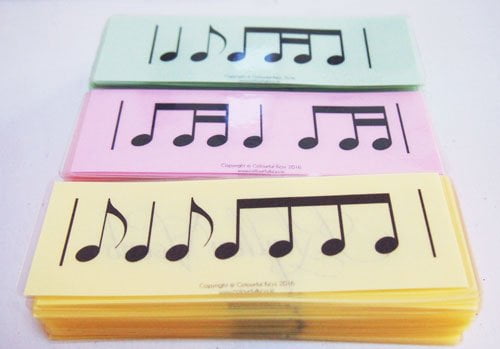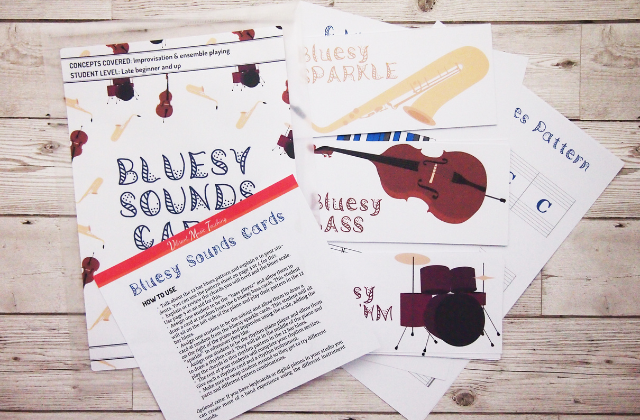
This blog post about teaching improvisation and composition to piano students was written by Chrissy Ricker. Chrissy is a piano teacher, composer and arranger from North Carolina, USA. She enjoys sharing ideas with other piano teachers and creating music to educate and excite piano students of all ages. When she’s not at the piano, you’ll probably find Chrissy reading a good science fiction novel or spending time with her husband, their dog and two cats. Learn more about Chrissy at her website.
We all know that teaching improvisation and composition is a great way for our piano students to unlock their creativity and get comfortable making music away from the written page. But did you know these activities can also be powerful tools for helping our students learn and memorise scales, chord progressions, accompaniment patterns and much more?

In this article, we’ll be exploring a few of the hidden benefits of teaching improvisation and composition, plus some specific ways you can harness the power of these activities in your studio.
Improvisation: Music’s Power Tool
Improvisation is a powerful tool to help students understand the reason they’re learning all of those pesky scale and chord patterns in their technical work. By improvising on a regular basis, in a variety of keys, your students will memorise these important musical building blocks more easily, boosting their creativity at the same time.
There are a variety of ways to incorporate improvisation into your lessons:
| Teacher duets | Create a simple teacher duet part using just the I and V chords of any key while your student improvises a melody line using notes from the scale. |
| Backing tracks | Use YouTube or MusiClock as a resource for backing tracks with basic chord progressions in a variety of keys. You could also make your own custom backing tracks with an app like iReal Pro. |
| Solo improvisation | After students are comfortable with the improvisation process, help them improvise complete pieces with both melody and harmony using scale and chord patterns. (More on that below. 👇) |
VMT members can use amazing sets of backing tracks from the VMT Library, where there are giant collections in major keys, minor keys, blues and more! Not a member? Learn more here.
Whichever teaching method you use, I find it helpful to start any piano improv activity by choosing two or three repeated rhythmic patterns that your students can use to create the melody of their improvisation. Once your students become comfortable with the process of improvising and keeping a steady beat, you can add more rhythmic variety to your improv sessions.
‘Rhythm Vocab Cards’ are a great resource for common rhythmic patterns in a variety of time signatures. Enter your info below, and Nicola will send a sample pack straight to your inbox.

Subscribe to the newsletter and get the RHYTHM VOCAB SAMPLE CARDS.
Enter your details to subscribe to the newsletter for piano teachers with information, tips and offers.
I hate spam as much as you do! I will only send you emails related directly to piano teaching and you can unsubscribe at any time.
Members of Vibrant Music Teaching can download the full sets of cards from the Printable Library. Not a member? You’re missing out on so much! Learn more at vibrantmusicteaching.com.
Hidden Benefit 1: Scale Memorisation
Scale-based improvisation allows students at every level to become confident at improvising melodies. As an added bonus, “playing around” with scales lays the groundwork for committing scales to memory.
Try some of these ideas for level-appropriate scale improvisation:
Beginners
Five-finger pentascales work great for beginning students, since they require no position shifts. Start with “white key only” options – C major, G major, A minor and D minor – and progress to other keys from there.
Late Beginners
As your late beginners learn the 12 major one-octave scales, use each one as the basis for an improv activity. Scale practice is extra fun when improvising over a backing track!
Early Intermediates
Once your students are confident in creating melodies with major scales, try exploring minor scales. Minor scales offer students greater variety in their improvisation efforts.
As a bonus, your students can experiment with the different sounds created by the natural, harmonic and melodic minor scales.
Intermediates
Students at this level might enjoy exploring the modes. Just imagine what amazing music might be made using a variety of modes:
- Dorian or Mixolydian modes can inspire mediaeval-sounding pieces
- Phrygian modes often give rise to stirring Spanish flamencos
- The chromatic scale will really animate virtuosic melodies
The sky’s the limit when it comes to intermediate students! ✈️
Hidden Benefit 2: Chord Progression Recollection
Jamming with chord progressions is a great way for your students to master chord theory and memorise the most common chords in each key. Ask students to play chord progressions while improvising a melody line using the pentascale or one-octave scale of a given key.
Remember: Start by letting your student choose two or three rhythmic patterns to use in their melody.
The following are a few chord progressions that can serve as the foundation for an improv activity for students at each level. These musical examples are shown in the key of C major, but when ready, have students transpose the patterns into a variety of keys and experiment with different inversions of each chord.
Beginners
Let’s take those pentascales we talked about above and have our beginners harmonise them with I and V chords in their most basic form, like this:

Late Beginners
Our late beginners can unleash their creativity while learning the primary chords (I, IV and V) in every major key. Use these chords to create a simple, 4-bar chord progression. For example:

Or jazz things up by introducing your students to the 12 bar blues progression, which uses these same 3 chords.

Want to explore the blues further with your students? Members of Vibrant Music Teaching will love the printable blues toolkit ‘Bluesy Sounds Cards’: a step-by-step way of teaching blues improvisation to your piano students.
This toolkit is just one of hundreds of practical, applicable resources instantly available to members. Still not a member? Learn more and take a tour at vibrantmusicteaching.com.
Early Intermediates
This group can “level up” their chord theory by adding the minor vi chord to the primary chords in major keys, letting them invent more sophisticated chord progressions.
Since these patterns are found so often in rock and pop music, your students should be able to spot these progressions in many of their favourite songs. See if they recognise this chord progression from the classic tune Heart and Soul or Ed Sheeran’s Perfect.

The following progression (below) uses the same four chords in a slightly different order.

This progression can be found in the classic rock song Don’t Stop Believin’ by Journey, as well as the more recent hit Someone You Loved by Lewis Capaldi.
Intermediates
I love introducing my intermediate students to the circle of fifths progression because it uses every diatonic chord within a key. Here, I’ve included the chord analysis for this progression in both A minor and C major, since the first half of it is frequently used on its own in pop music.

It’s helpful to know this progression since it can be found in everything from Baroque music (e.g. Handel’s Passacaglia) to jazz standards (e.g. Fly Me to the Moon).
Hidden Benefit 3: Accompaniment Pattern Toolkit
Once students are comfortable improvising with the chord progressions above, help them build a working toolbox of left hand accompaniment patterns they can use in future improv and composition projects. Here are a few of my favourite easy accompaniment patterns to use with students.

Memorising common accompaniment patterns is extremely valuable, since students will often encounter them in their repertoire as well.
Making the Leap to Composition
Now that your students have some experience with improvisation, they can make the leap to composition by notating some of their favourite improvised creations.
Hidden Benefit 4: Transcription and Notation Review
I like to start out with my students notating their compositions the old-fashioned way – with pencil and staff paper.
Asking students to transcribe their works on paper gives you the opportunity to review concepts like stem and beaming rules. In addition, writing their creations on the staff gives students:
- Extra practice drawing musical symbols such as clefs, time signatures, key signatures etc.
- A solid grasp of note placement on the staff
- Experience correctly notating rhythmic patterns
- A deeper understanding of music vocabulary by selecting appropriate tempo markings, dynamics and articulations

Do you include improv and composition in your weekly lessons?
If so, what hidden benefits have you discovered?🙂
Nicola’s hub page devoted to teaching creative skills is chock full of resources to help you get started with improvising and composing, or to level-up the skills you already have.
